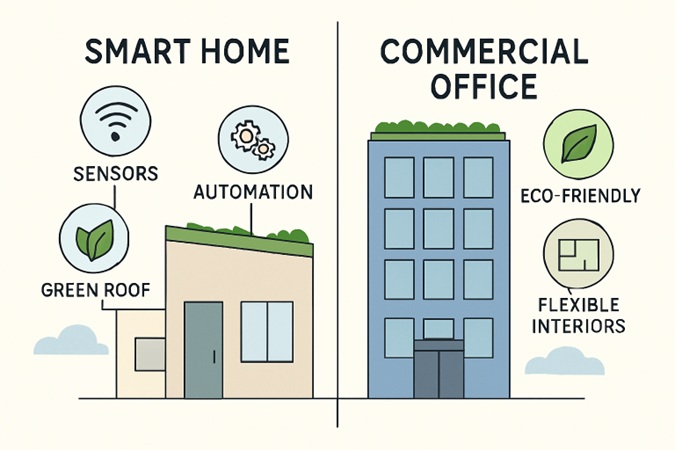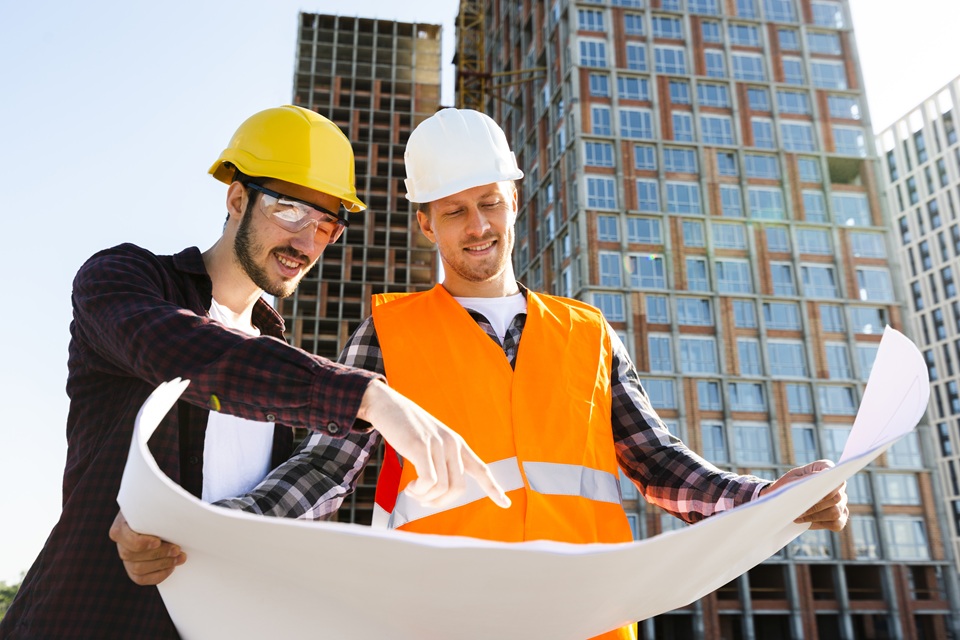Key Takeaways:
- Smart technologies, such as Internet of Things (IoT) devices and automation, are transforming building management and user experiences in unprecedented ways.
- Sustainable construction now prioritizes the selection of eco-friendly building materials, advanced energy management systems, and environmentally responsible operational practices.
- Flexible, adaptable spaces are designed to accommodate evolving occupant requirements, whether that means transitioning from a home office to a guest room or supporting changing business needs.
- Health and wellness considerations—spanning air quality to biophilic design—play an increasing role in architectural and interior design choices.
- New modular and prefabricated construction methods are making building projects faster, more predictable, and often more cost-effective, benefiting a wide range of property types.
Construction is undergoing a dramatic transformation, driven by shifting societal demands and rapid technological advancements. Today, both residential and commercial projects are shaped by a desire for efficiency, sustainability, and occupant wellness. The construction industry is no longer just about erecting structures—it’s about creating environments that are smarter, healthier, and more adaptable. Embracing these trends is not just an option but a necessity for those involved in new builds or renovations. Leading firms like Snyder Construction are setting benchmarks by leveraging the latest practices, innovative technologies, and advanced materials, delivering superior results that cater to the modern market’s expectations.
Whether you’re a homeowner dreaming of a more functional living space, a developer planning a cutting-edge office building, or an investor seeking future-proof property assets, understanding these modern construction trends is crucial to making informed decisions. Modern approaches—such as innovative space utilization, the adoption of eco-friendly materials, and the integration of intelligent automation—are no longer seen as optional perks but as requirements that differentiate average builds from excellent ones. These advancements are fundamentally changing the way we design, construct, and inhabit both workspaces and homes, resulting in environments that are flexible, sustainable, and far more comfortable than those of just a decade ago.
Smart Technologies & IoT Integration
The integration of smart technologies and the Internet of Things (IoT) is revolutionizing both residential and commercial construction at its core. In today’s buildings, automated systems enable users to remotely control and optimize various aspects, including lighting, HVAC, security systems, and access controls, thereby making properties more energy-efficient and comfortable for occupants. The increased availability of features such as automated thermostats, app-based lighting controls, voice-activated assistants, and networked, intelligent sensors is pushing the concept of smart buildings beyond luxury markets into the mainstream. Modern occupants expect buildings to adapt to their needs through automation, improving daily routines and simplifying building management.
Developers and building managers are increasingly adopting sophisticated building automation systems (BAS) that allow real-time monitoring of all systems and predictive maintenance capabilities. These systems can highlight inefficiencies, produce actionable usage analytics, and even schedule servicing before issues become critical, thereby reducing long-term operating costs. Commercial office towers, hospitals, apartment complexes, and single-family homes can all be managed more efficiently and securely, thanks to the rapid proliferation of IoT-enabled devices. The use of smart technologies is also essential in supporting emerging trends, such as remote work and flexible leasing arrangements, both of which benefit from environments that can be quickly adjusted to meet new requirements.
Sustainable Building Practices
As the global focus on climate change and environmental responsibility intensifies, sustainable building practices are quickly becoming a top priority throughout the construction sector. Today’s builders are not only interested in energy savings but are also embracing eco-friendly materials such as recycled steel, reclaimed wood, bamboo, and low-VOC paints and adhesives. Solar panels, green roofs, high-performance energy-efficient windows, and advanced insulation solutions are being incorporated into the design and construction phases to minimize the environmental footprint of new buildings. Many construction firms are actively seeking innovative solutions for waste management and water conservation as well.
These sustainability initiatives offer dual benefits: they contribute to resource conservation and environmental protection while significantly reducing utility expenses over the long run for both occupants and building owners. Developers and property managers are also seeking industry-recognized certifications such as LEED (Leadership in Energy and Environmental Design), which signals a strong commitment to sustainable practices. According to Architectural Digest, green buildings have become a substantial selling point, attracting a new generation of eco-conscious buyers and tenants who value responsible living and working environments. These practices are expected to continue growing as regulations tighten and consumer expectations shift toward greener solutions.

Adaptable, Multi-Use Living Spaces
The COVID-19 pandemic era dramatically triggered new demands for flexible spaces that can easily adapt to changing lifestyles and work patterns. Modern homes and offices are now being designed for maximum versatility, using open floor layouts and modular furniture that permits effortless conversions from one function to another. This shift means that rooms must often perform double or triple duty: home offices transition to guest rooms or gyms, dining areas may become remote work zones, and standard rooms serve as both entertainment and study spaces for families.
This adaptability trend extends well into the commercial property realm. Businesses are moving toward shared workspaces and collaborative environments that supersede outdated rows of fixed cubicles. Many retail and hospitality spaces are also adopting flexible layouts, using movable partitions and dynamic, multipurpose areas that can be tailored for pop-up shops or different customer experiences as trends and customer needs rapidly evolve. This adaptability is making buildings far more resilient to market shifts and tenant turnover, ensuring long-term property value and relevance.
Wellness-Centric Designs
There’s a growing recognition across the construction industry that our built environments have a direct and lasting impact on health, mood, and productivity. As a result, wellness-centric design philosophies are gaining traction. Savvy builders are incorporating features such as expansive windows for maximizing daylight, advanced circadian lighting systems that support natural sleep cycles, extensive use of indoor greenery, upgraded air filtration systems to tackle indoor pollutants, and even touchless infrastructure to mitigate the spread of germs. Residential buildings benefit from wellness amenities, including air purification, ergonomic design, and outdoor access. At the same time, commercial spaces are increasingly being certified to meet the WELL Building Standard, which benchmarks environments that promote both physical and psychological well-being.
Research has consistently shown that workplaces and living environments rich in biophilic elements—such as natural light, organic materials, views of nature, and indoor plants—lead to improved productivity, creativity, and overall occupant satisfaction.
Modular & Prefabricated Construction
Changing economic conditions, rising labor and material costs, and ongoing supply chain constraints have made modular and prefabricated construction methods more attractive than ever. These innovative approaches involve producing major building elements—including walls, floors, and even entire rooms or pods—off-site in climate-controlled facilities, then transporting them to the build location for fast, precise assembly. This not only reduces material waste but also leads to better quality control, as factory conditions minimize deviations caused by weather or human error on traditional sites. Frequently, modular construction achieves faster project completions, keeping budgets in check and enabling quicker occupancy.
Modular construction methods are especially beneficial for projects with accelerated timelines, such as emergency healthcare clinics, rapid-deployment schools, or multifamily housing developments responding to fast-growing urban populations. The predictability of factory-based assembly results in significant reductions in scheduling delays and often yields higher-quality structures. As more developers and architects realize the flexibility and efficiency of these streamlined building processes, modular construction is swiftly becoming a standard practice in both residential and commercial sectors—and a powerful tool in overcoming the traditional bottlenecks associated with conventional, on-site construction techniques.
Conclusion
The expansion of smart technologies, commitment to sustainability, flexible design approaches, and the integration of wellness considerations are collectively reshaping the construction landscape in profound ways. Modular and prefabricated solutions offer a glimpse into what the future holds: faster, more efficient, and more resilient building practices. By staying ahead of these trends and adapting to continuous technological change, developers, builders, and property owners can ensure their projects remain relevant, desirable, and equipped to thrive amidst shifting market demands. The era of visionary, forward-thinking construction is already here—those who embrace these advancements are positioning themselves at the forefront of a truly transformative time in the industry.
